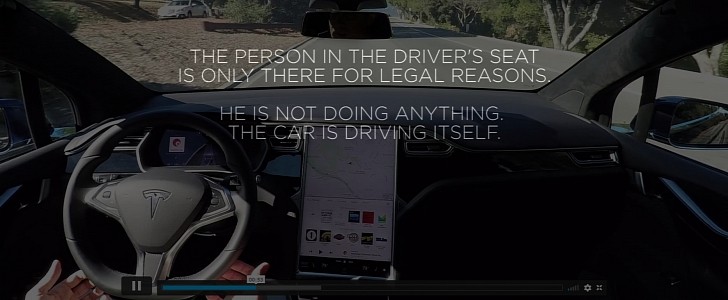No other company bets on a camera-only autonomous driving strategy apart from Tesla. If you wonder why that is the case, The New York Times said that it was something Elon Musk insisted on, even going against his own specialists.
According to the NYT, Tesla would even have pretended Autopilot was better than it actually was in a 2016 video. The company would have created a 3D map for the vehicle to perform flawlessly in the path Tesla chose to film it. Despite the precautions, the Model X used to demonstrate the technology would have hit a “roadside barrier on Tesla property” and had to be repaired.
The video was edited not to include the crash. It just brings a disclaimer stating that “the person in the driver’s seat is only there for legal reasons. He is not doing anything. The car is driving itself.” At the sound of “Paint it Black” from the Rolling Stones, the car seems to do exactly what the disclaimer describes with Autopilot. However, the Tesla ADAS does not have a 3D map to follow.
The NYT talked to 19 people who worked on the Autopilot project over the last decade. Many confirmed that Musk pushed for the vision-only autonomous driving strategy despite engineers in Tesla’s team warning that cameras would not be enough and that safety could be compromised by not relying on more sensors.
One of these engineers, called Hal Ockerse, proposed to create a redundancy system to monitor and eventually replace Autopilot components in case they failed. Musk scolded the engineering manager for the idea. Ockerse left Tesla a while later.
This is not the only example of Musk imposing his will against the recommendation of his engineers. In late 2014, when the Model S started receiving radars to work with Autopilot, Musk ordered his team to put a rubber seal to hide the component. It appeared through a hole in the front of the electric sedan. Musk was warned that the seal could collect snow and ice, which would make the radar malfunction, but those arguments did not convince him.
A while later, customers complained that the radar would not work in the winter. That was when the company decided to test the rubber seal and fix it. This is probably another episode of Musk’s policy described by Philippe Chain, a VP for quality at Tesla when the Model S was released.
According to this executive, when he warned Musk the Model S needed more testing before being presented, the Tesla CEO said they should just repair whatever was wrong later if it was essential. Tesla could also try to fix anything with OTA (over-the-air) updates. While that may work with software, it is not the best policy for vehicles, especially when a team tells you to do otherwise.
The video was edited not to include the crash. It just brings a disclaimer stating that “the person in the driver’s seat is only there for legal reasons. He is not doing anything. The car is driving itself.” At the sound of “Paint it Black” from the Rolling Stones, the car seems to do exactly what the disclaimer describes with Autopilot. However, the Tesla ADAS does not have a 3D map to follow.
The NYT talked to 19 people who worked on the Autopilot project over the last decade. Many confirmed that Musk pushed for the vision-only autonomous driving strategy despite engineers in Tesla’s team warning that cameras would not be enough and that safety could be compromised by not relying on more sensors.
One of these engineers, called Hal Ockerse, proposed to create a redundancy system to monitor and eventually replace Autopilot components in case they failed. Musk scolded the engineering manager for the idea. Ockerse left Tesla a while later.
This is not the only example of Musk imposing his will against the recommendation of his engineers. In late 2014, when the Model S started receiving radars to work with Autopilot, Musk ordered his team to put a rubber seal to hide the component. It appeared through a hole in the front of the electric sedan. Musk was warned that the seal could collect snow and ice, which would make the radar malfunction, but those arguments did not convince him.
A while later, customers complained that the radar would not work in the winter. That was when the company decided to test the rubber seal and fix it. This is probably another episode of Musk’s policy described by Philippe Chain, a VP for quality at Tesla when the Model S was released.
According to this executive, when he warned Musk the Model S needed more testing before being presented, the Tesla CEO said they should just repair whatever was wrong later if it was essential. Tesla could also try to fix anything with OTA (over-the-air) updates. While that may work with software, it is not the best policy for vehicles, especially when a team tells you to do otherwise.














